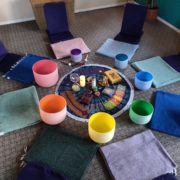Does including music in a yoga class add to the healing benefits?
When I first started taking yoga classes years ago back in New Jersey, the teachers did not play music in the background. There might have been some chanting, as I do remember learning about chanting “Om” and “Shanti” to start and end classes. However, it wasn’t until I attended a class where the teacher played the quartz crystal singing bowls while we stayed in comfortable, supported shapes that sound caught my attention! I left that class sensing that something deep inside of me had shifted, although I could not put it in to words at that time. After moving to California, I noticed that most yoga teachers included music in their classes, whether it was simply nature sounds or straight up rock and roll! So once I became a yoga teacher, I began to include music in my classes while setting the intention to manifest a set of those singling bowls so I too one day would be able to offer that deeper experience to others.
After a few years, I acquired a set of Tibetan singing bowls which were made out of metal and generated different sound frequencies depending upon their size and thickness. The belief was that the frequency of each bowl was tuned to the seven major chakras, or energy centers, in the body, causing the human body to begin to vibrate at the same frequency as the bowls, referred to as entrainment. The process of entrainment of the body’s frequencies to the sound frequencies of the singing bowls was thought to help the body recover and align with its natural, dominant vibration of wellness (versus illness). At the time, I didn’t have any evidenced-based research to prove such claims, I only had my own personal anecdotal experiences. Although I think most of us would not argue how music impacts us, research is now starting to show how these specific vibrations from the singing bowls impact mood and Heart Rate Variability, a physiological measure of health.
Now, you have to understand, that although I love music, I do not have any musical talent. I sing, but not well and only when I am alone and I have no musical instrument training. I also avoided group exercise classes (before yoga) because I always felt I was a step behind everyone else – yes, I believed I had no rhythm or coordination, instead of knowing I simply vibrate at a different frequency! It wasn’t until my yoga practice expanded my awareness to the fact that sound, vibration, rhythm, resonance and dissonance permeate the universe. Those sounds start for us in the womb, where we hear our mother’s heartbeat, pulse and breathing (and entrain with these vibrations) and we remain rhythmic beings until we take our very last breath. And not only are we rhythmic beings, but all sentient beings vibrate, especially when we allow ourselves to tune into nature. In fact, if you would like to experiment with some healing sounds of nature, click here to listen to the sounds of birds and sense how stress and anxiety simply melt away!
The intention behind the physical movement and shapes of a yoga practice on the mat is to soften the mind’s activity, by helping it to focus on the body and breath and releasing the tight grip of the thoughts that keep us distracted. As we practice yoga, the brain waves of the mind change. The higher frequency brain waves (i.e., Gamma and Beta) begin to slow down. These higher frequency brain waves are associated with stress, anxiety, and fear. When the singing bowls are included in the physical practice of yoga, in addition to the physically felt vibrations, the bowls emit measurable waveforms that sound pleasant and soothe the mind and emotions by promoting the slower, more meditative alpha and theta brain wave states. So, over 15 years later, I couldn’t be happier that I have manifested a beautiful colored set of quartz crystal singing bowls to include in my yoga and meditation classes!
And I’m also excited to learn that therapeutic sound and music is permeating other healing spaces too. The recent increase in research on the use of music in healing has shown a strong effect on the brain, including rebuilding neural connections, increasing neuroplasticity, balancing brain activity in the emotional centers such as the amygdala and hippocampus, and enhancing reward (e.g., release of dopamine) circuitry, which helps to regulate mental and emotional responses. The research is compelling enough that music therapy is being integrated in military treatment facilities, such as the Walter Reed Medical Center, to treat combat-related traumatic brain injuries and post-traumatic stress disorder. So, the next time you are in a movement class and sense the enjoyment of the music, know that the sounds and vibrations are working at a deeper, subconscious level to invite the body to entrain to its natural vibration of health. Nothing for you to do, simply enjoy!
If you would like to read more about how music is being integrated into military treatment facilities for trauma-induced mind-body dysregulation, click on the link below:



